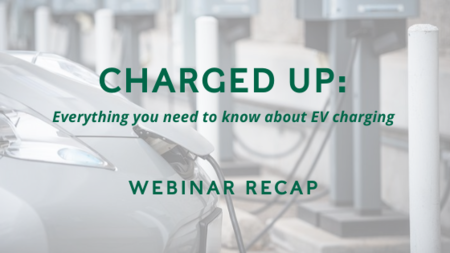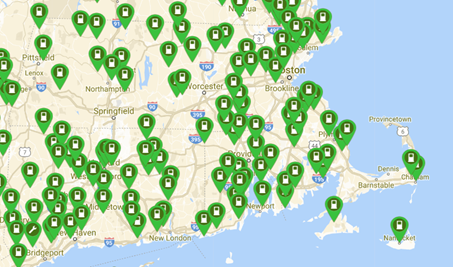
There are many reasons to switch to an electric car - lower carbon emissions, less engine maintenance, and smooth handling, to name a few. But even if you’re sold on the consumer benefits of driving on electricity, it can still be a little intimidating to learn how to charge when you’re used to refueling with gasoline.
“Charged up: Everything you need to know about EV charging” is a 50-minute long webinar to make your transition to an electric vehicle as smooth as possible. View the whole webinar below.
The two questions that everyone has when they first learn about electric cars are “how far can they go?” and “how fast can they charge?”
How far an electric car can go on a single charge depends on the size of the battery, vehicle efficiency, and weather. Whereas how fast the car can charge depends on the voltage and current output of the power source, the capacity of the car's onboard charger, and the weather.
The weather, specifically ambient temperature, affects both range and charging rate. If you live in a place with cold winters, like New England, you’ll notice your EV’s performance change in the wintertime compared to warm-weather months. Learn more about winter driving here.
There are three distinct charging speeds for EVs: Level 1, Level 2, and fast charging. Level 1 is the slowest, and it’s exactly like charging a smartphone or laptop. All plug-in vehicles are sold with a cable that plugs into the car’s charging port and into a regular 120-volt household outlet. Because these outlets don’t deliver very much power, EVs charging at Level 1 gain 2 -6 miles of range per hour of charging, which isn’t very fast. However, the convenience and ease of using a regular outlet means that Level 1 charging can be really useful if your car spend lots of time parked in one place with an outlet nearby.
Level 2 charging allows an EV to charge at a rate of 11 – 25 miles per hour, depending on the vehicle model. This charging speed would completely recharge an electric vehicle with a 250-mile driving range if plugged in overnight, so Level 2 charging makes driving an EV practical for many people.
The maximum Level 2 charging rate of any vehicle is determined by the power of its onboard charger. See the table below to compare different EVs and their maximum Level 2 charging rates.
| Onboard charger |
Maximum Level 2 charging rate* |
Cars |
| 7.7 - 10 kW |
25-30 |
Tesla Model 3, Tesla Model S, Tesla Model X |
| 7.4 kW |
24 |
BMW i3 |
| 6.6 - 7.2 kW |
22-24 |
Nissan LEAF, Chevrolet Bolt, Hyundai Kona EV, Kia Niro EV, VW e-Golf, Hyundai Ioniq EV, Chrysler Pacifica |
| 3.3 - 3.7 kW |
11 |
Toyota Prius Prime, Honda Clarity PHEV, Mitsubishi Outlander PHEV, Kia Niro PHEV, Chevrolet Volt |
* Miles of range gained per hour of charging.
Level 2 charging requires both a 240-volt outlet and a charging station unit, both of which can be installed at home by a licensed electrician. If you’re interested in charging at Level 2 speed at home, check out our “Installing Electric Vehicle Charging at Home” guide to learn how to pick a charging station unit and factors that may affect the cost of your installation. It typically costs around $1,000 to install a charging station, but since electricity is much cheaper than gasoline, the station will pay for itself through fuel savings. For more information, view our Consumer Savings page.
There’s also plenty of Level 2 charging available for public use. Unless you already drive an EV, you might not have noticed charging stations because they’re inconspicuously located in parking lots and other places where cars are expected to stop for a few hours, like grocery stores and gyms. Smartphone apps like PlugShare make it easy to find stations near where you work, live, or travel.

The cost to charge at public stations can vary depending on the time you spend parked or the amount of energy you consume, but many are free to use. Because of investments from private charging networks, utility companies, and Volkswagen settlement funds, public charging stations are expanding rapidly and can be a good supplement to charging at home, especially if you live in a dense urban area and can’t install Level 2 charging.
Level 1 and Level 2 charging can help you meet the majority of your charging needs, but many people, when thinking about the practicality of a vehicle, need to consider the occasional long distance trip. DC fast charging allows EVs to charge faster despite the limitations of onboard chargers. A 25-kilowatt fast charger can add 50 miles of range in 30 minutes of charging, and many modern EVs have maximum fast charging rates that add as much as 120 miles of range in 30 minutes of charging.
Because it can cost as much as $40,000 to install a single DC fast charging plug, the priority is to install them along major highway corridors with a lot of through-traffic, such as I-90 and I-95. Strategic installation of DC fast charging allow EVs to be practical for driving hundreds of miles in a day, but because of the high heat introduced to the battery during fast charging, it’s not a good option for daily use. The majority of EV drivers rely mostly on Level 1 and Level 2 charging because it’s cheaper and more convenient.
DC fast charging may get fast enough to challenge the 5-minute refuel time of gasoline someday, but electric vehicles are already practical for many people with a simple change in habit. Most drivers refuel their gas tank when nearly empty, but EV charging is done more often because it takes just 10 seconds to plug in. New EV drivers learn to charge opportunistically when their car is parked to replenish to the miles they’ve driven that day.
Charging an electric vehicle takes a little adjustment, but is easier than you might think. If you still have questions about charging, like what kind of EV is right for you or best practices for charging to extend the longevity of your battery life, email drivegreen@greenenergyconsumers.org.
For a PDF version of the webinar slides, click here.


Comments